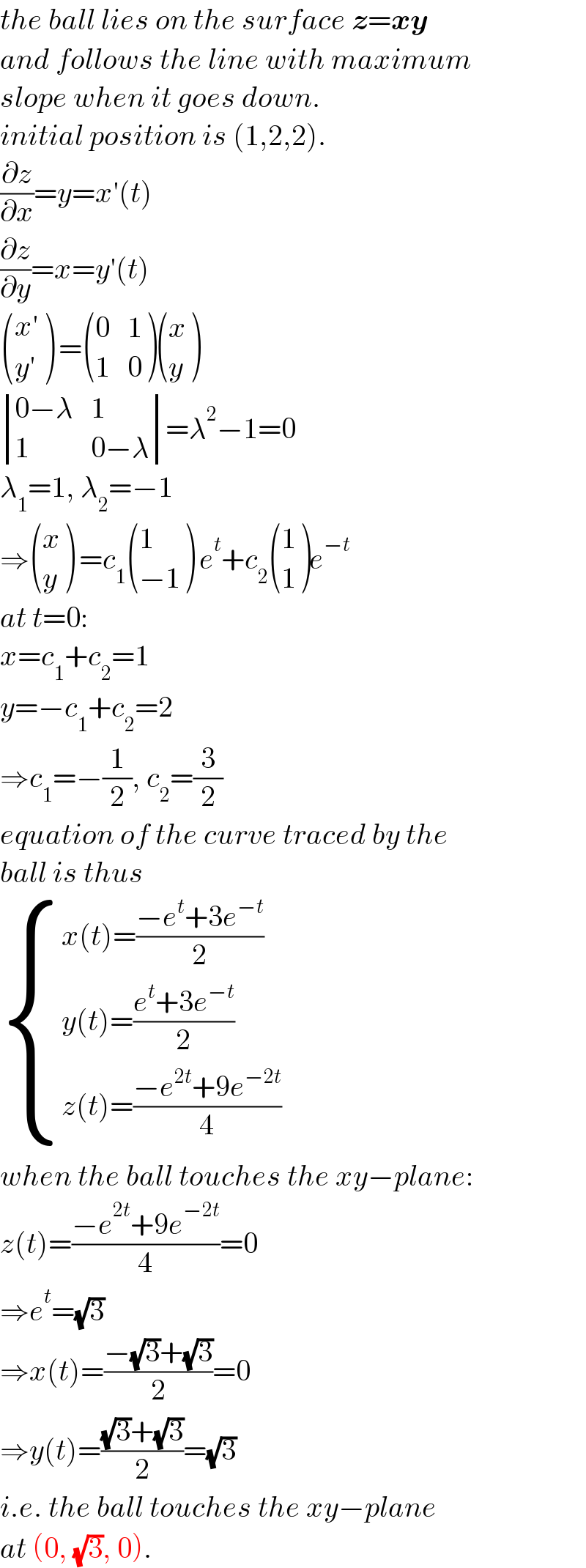Question Number 201214 by mr W last updated on 02/Dec/23

$$\mathrm{A}\:\mathrm{ball}\:\mathrm{lies}\:\mathrm{on}\:\mathrm{the}\:\mathrm{function}\:{z}={xy}\:\mathrm{at} \\ $$$$\mathrm{the}\:\mathrm{point}\:\left(\mathrm{1},\mathrm{2},\mathrm{2}\right).\:\mathrm{Find}\:\mathrm{the}\:\mathrm{point}\:\mathrm{in} \\ $$$$\mathrm{the}\:{xy}−\mathrm{plane}\:\mathrm{where}\:\mathrm{the}\:\mathrm{ball}\:\mathrm{will} \\ $$$$\mathrm{touch}\:\mathrm{it}. \\ $$$$ \\ $$$$\left({an}\:{unsolved}\:{old}\:{question}\:{Q}\mathrm{200929}\right) \\ $$
Answered by mr W last updated on 03/Dec/23

$${the}\:{ball}\:{lies}\:{on}\:{the}\:{surface}\:\boldsymbol{{z}}=\boldsymbol{{xy}} \\ $$$${and}\:{follows}\:{the}\:{line}\:{with}\:{maximum} \\ $$$${slope}\:{when}\:{it}\:{goes}\:{down}. \\ $$$${initial}\:{position}\:{is}\:\left(\mathrm{1},\mathrm{2},\mathrm{2}\right). \\ $$$$\frac{\partial{z}}{\partial{x}}={y}={x}'\left({t}\right) \\ $$$$\frac{\partial{z}}{\partial{y}}={x}={y}'\left({t}\right) \\ $$$$\begin{pmatrix}{{x}'}\\{{y}'}\end{pmatrix}\:=\begin{pmatrix}{\mathrm{0}}&{\mathrm{1}}\\{\mathrm{1}}&{\mathrm{0}}\end{pmatrix}\begin{pmatrix}{{x}}\\{{y}}\end{pmatrix} \\ $$$$\begin{vmatrix}{\mathrm{0}−\lambda}&{\mathrm{1}}\\{\mathrm{1}}&{\mathrm{0}−\lambda}\end{vmatrix}=\lambda^{\mathrm{2}} −\mathrm{1}=\mathrm{0} \\ $$$$\lambda_{\mathrm{1}} =\mathrm{1},\:\lambda_{\mathrm{2}} =−\mathrm{1} \\ $$$$\Rightarrow\begin{pmatrix}{{x}}\\{{y}}\end{pmatrix}\:={c}_{\mathrm{1}} \begin{pmatrix}{\mathrm{1}}\\{−\mathrm{1}}\end{pmatrix}\:{e}^{{t}} +{c}_{\mathrm{2}} \begin{pmatrix}{\mathrm{1}}\\{\mathrm{1}}\end{pmatrix}{e}^{−{t}} \\ $$$${at}\:{t}=\mathrm{0}: \\ $$$${x}={c}_{\mathrm{1}} +{c}_{\mathrm{2}} =\mathrm{1} \\ $$$${y}=−{c}_{\mathrm{1}} +{c}_{\mathrm{2}} =\mathrm{2} \\ $$$$\Rightarrow{c}_{\mathrm{1}} =−\frac{\mathrm{1}}{\mathrm{2}},\:{c}_{\mathrm{2}} =\frac{\mathrm{3}}{\mathrm{2}} \\ $$$${equation}\:{of}\:{the}\:{curve}\:{traced}\:{by}\:{the}\: \\ $$$${ball}\:{is}\:{thus} \\ $$$$\begin{cases}{{x}\left({t}\right)=\frac{−{e}^{{t}} +\mathrm{3}{e}^{−{t}} }{\mathrm{2}}}\\{{y}\left({t}\right)=\frac{{e}^{{t}} +\mathrm{3}{e}^{−{t}} }{\mathrm{2}}}\\{{z}\left({t}\right)=\frac{−{e}^{\mathrm{2}{t}} +\mathrm{9}{e}^{−\mathrm{2}{t}} }{\mathrm{4}}}\end{cases} \\ $$$${when}\:{the}\:{ball}\:{touches}\:{the}\:{xy}−{plane}: \\ $$$${z}\left({t}\right)=\frac{−{e}^{\mathrm{2}{t}} +\mathrm{9}{e}^{−\mathrm{2}{t}} }{\mathrm{4}}=\mathrm{0} \\ $$$$\Rightarrow{e}^{{t}} =\sqrt{\mathrm{3}} \\ $$$$\Rightarrow{x}\left({t}\right)=\frac{−\sqrt{\mathrm{3}}+\sqrt{\mathrm{3}}}{\mathrm{2}}=\mathrm{0} \\ $$$$\Rightarrow{y}\left({t}\right)=\frac{\sqrt{\mathrm{3}}+\sqrt{\mathrm{3}}}{\mathrm{2}}=\sqrt{\mathrm{3}} \\ $$$${i}.{e}.\:{the}\:{ball}\:{touches}\:{the}\:{xy}−{plane} \\ $$$${at}\:\left(\mathrm{0},\:\sqrt{\mathrm{3}},\:\mathrm{0}\right). \\ $$
Commented by mr W last updated on 02/Dec/23

$${if}\:{the}\:{ball}\:{is}\:{initially}\:{at}\:\left(\sqrt{\mathrm{2}},\:\sqrt{\mathrm{2}},\:\mathrm{2}\right), \\ $$$${c}_{\mathrm{1}} +{c}_{\mathrm{2}} =\sqrt{\mathrm{2}} \\ $$$$−{c}_{\mathrm{1}} +{c}_{\mathrm{2}} =\sqrt{\mathrm{2}} \\ $$$$\Rightarrow{c}_{\mathrm{1}} =\mathrm{0},\:{c}_{\mathrm{2}} =\sqrt{\mathrm{2}} \\ $$$${equation}\:{of}\:{the}\:{curve}\:{traced}\:{by}\:{the}\: \\ $$$${ball}\:{is}\:{then} \\ $$$$\begin{cases}{{x}\left({t}\right)=\sqrt{\mathrm{2}}{e}^{−{t}} }\\{{y}\left({t}\right)=\sqrt{\mathrm{2}}{e}^{−{t}} }\\{{z}\left({t}\right)=\mathrm{2}{e}^{−\mathrm{2}{t}} }\end{cases} \\ $$
Commented by mr W last updated on 02/Dec/23

Commented by mr W last updated on 02/Dec/23

Commented by Akira181 last updated on 05/Mar/24

$$\mathrm{It}\:\mathrm{is}\:\mathrm{pretty}\:\mathrm{sure},\:\mathrm{congratulations}! \\ $$$$\mathrm{I}\:\mathrm{took}\:\mathrm{other}\:\mathrm{way}\:\mathrm{by}\:\mathrm{first}\:\mathrm{parametrizing} \\ $$$$\mathrm{and}\:\mathrm{simplifying}\:\mathrm{as}\:\mathrm{square}\:\mathrm{roots}. \\ $$
